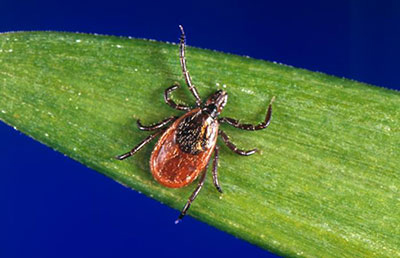
| May 2018 | |||||||||||
| Top stories | |||||||||||
| In the news | |||||||||||
| Photos | |||||||||||
| Contact us | |||||||||||
| Archive | |||||||||||
|
Vector-borne illnesses are on the rise |
May 31, 2018 --
The number of diseases spread by mosquito, tick and flea bites has tripled in the US from more than 27,000 in 2004 to more than 96,000 in 2016.
 Deer tick.
Deer tick.
These insects are known as vectors and can spread viruses and bacteria. Sixteen vector-borne diseases were reported to the CDC in these 13 years. The State Hygienic Laboratory tests for many of these, including West Nile virus, Zika and Rocky Mountain spotted fever (RMSF).
Many infections are not reported or recognized, so it is difficult to accurately estimate the overall cost and burden of these diseases.
The CDC reported the increase of these diseases in its May 2018 issue of Vitalsigns and case counts by states in its National Notifiable Diseases Surveillance System.
In Iowa and the nation, the most common tick-borne disease is Lyme disease. The Iowa Department of Public Health reports that preliminary 2017 case counts in the state show 254 cases of Lyme disease, 17 cases of RMSF, and 24 cases of ehrlichiosis, which is spread by the lone star tick most often in the southeastern and southcentral United States. All these numbers are increases over 2016.
IDPH tracks the number of these conditions and other reportable diseases in its Iowa Surveillance of Notifiable and Other Diseases.
The best way to prevent tick bites is to avoid wooded and grassy areas where ticks are usually found. If you do spend time in these areas:
- Avoid wooded and brushy areas with high grass and leaf litter.
- Walk in the center of trails.
- Use repellent that contains 20 percent or more DEET, picaridin or IR3535 on exposed skin for protection that lasts several hours.
- Always follow product instructions. Parents should apply this product to their children, avoiding hands, eyes and mouth.
- Use products that contain permethrin on clothing. Treat clothing and gear, such as boots, pants, socks and tents, with products containing 0.5% permethrin. It remains protective through several washings. Pre-treated clothing is available and may be protective longer.
- The Environmental Protection Agency (EPA) has an online tool to help you select the repellent that is best for you and your family.
Not everyone who gets Lyme disease will have the same symptoms, but the best and earliest sign of infection is a rash that may appear within a few days to a month, usually at the site of the tick bite. The rash will first look like a small red bump, then expand until it begins to look like a bull’s eye, with a red center and a red ring surrounding a clear area. It is important to contact your healthcare provider immediately if you develop this type of rash or develop flu-like symptoms within a month of having a tick bite or being in an area where ticks are present.